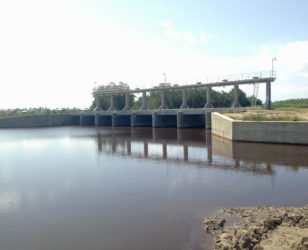The Hope Canal on the East Coast of Demerara has helped to alleviate flooding in Region Five as it was effective in draining the excess water from the East Demerara Water Conservancy (EDWC).
Region Five chairman, Vickchand Ramphal told Stabroek News yesterday that it was one of the reasons that the Mahaica area did not suffer much flooding despite the inclement weather.
In the past, Ramphal noted, “When the water reached to a maximum level in the East Demerara Water Conservancy, the NDIA [National Drainage & Irrigation Authority] would release it into Mahaica River and then it would go into the Mahaicony Creek and to some extent the Abary Creek.

The controversial Hope Canal to drain the EDWC was one of the major projects commissioned under the Donald Ramotar administration.
Ramphal said that with the present weather conditions, there was no need to pump water into the Mahaica Creek; the Hope canal has “helped a lot.” The chairman said too that had it not been for the canal, the “effects of the flood would have been more devastating.”
According to him, “A few communities along the Mahaica Creek has experienced flooding but not as serious as the other areas; Mahaicony and to some extent, Abary.
A resident of Big Biaboo, Mahaica, Naresh Bhagwandin who is engaged in cattle and plantain farming, confirmed that there is still slight flooding in the area.
Since the flooding started he has been pumping water to save his cattle and plantain farm. He mentioned though that the plantain is being affected by the moko disease.
He had sought the advice of the Caribbean Agricultural Research & Development Institute [CARDI] but was told that the disease “has no cure.”
Other residents said they suffered losses to a small amount of cash crops and were thankful that the flooding was not as bad as they had suffered in the past.
“The [Hope] Canal is functioning well so we are not affected by flooding much now. Only the people on the flat would get flood sometimes,” a resident said.
According to residents, the floodwater has been on the land for about one month now since the rainy weather started. The water started to recede shortly after when the Mahaica, Mahaicony, Abary-Agricultural Development Authority (MMA-ADA) started pumping it into an empoldered area.
But the residents said, they observed that when the water reached a certain level, the pumps stopped working, although they remained in the area.
On the other hand, the Mahaicony Creek has been severely affected by flooding, due mainly to heavy rainfall and flooding in Moraikobai, in the upper reaches of the creek. Residents said the Mora Point pump, which provides relief to them, is not working.
Sewrattie Sohanlall of Yarrow Creek, Mahaicony told this newspaper yesterday that the water has started to recede and was happy that she “can see a piece of meh bottom house.” She was afraid that the water would come up again with the tide though.
She had already started to reap produce from her kitchen garden when the floods came and destroyed it.
The woman and her husband, who is a labourer, also rear livestock, which they have moved to the “high spot.”
Areas such as Trafalgar, Lovely Lass, Number 29, 30 and 31 villages were inundated, mostly because the main koker and channel in Trafalgar were blocked and the water from the excess rainfall flowing down the river was unable to flow through to the sea.
Ramphal had told Stabroek News that the NDIA in collaboration with the MMA-ADA had sent several excavators and pumps around the region to aid with drainage.
Yesterday, the chairman said that the water was receding “fairly well.” He said too that the Trafalgar/Lovely Lass area is “relatively low” and that the Onverwagt Canal provides the main drainage from the backlands.
He pointed out that all of the drainage systems need to be desilted to avoid further flooding.
Meantime, Ramphal said that rice farmers in the region have suffered twice; first with the El Nino and now with flooding.
He said they are hoping to have some form of relief, such as fertiliser, fuel or even cash from the government because of the extra expenses they have incurred.




